介绍欧洲专利侵权主要判定原则
- 格式:ppt
- 大小:2.42 MB
- 文档页数:43
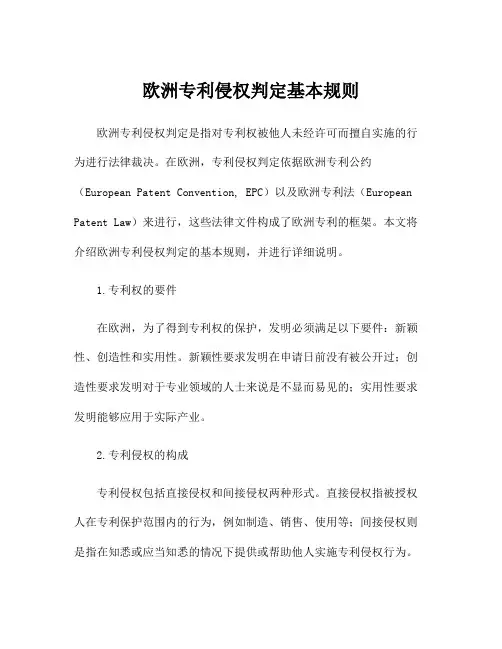
欧洲专利侵权判定基本规则欧洲专利侵权判定是指对专利权被他人未经许可而擅自实施的行为进行法律裁决。
在欧洲,专利侵权判定依据欧洲专利公约(European Patent Convention, EPC)以及欧洲专利法(European Patent Law)来进行,这些法律文件构成了欧洲专利的框架。
本文将介绍欧洲专利侵权判定的基本规则,并进行详细说明。
1.专利权的要件在欧洲,为了得到专利权的保护,发明必须满足以下要件:新颖性、创造性和实用性。
新颖性要求发明在申请日前没有被公开过;创造性要求发明对于专业领域的人士来说是不显而易见的;实用性要求发明能够应用于实际产业。
2.专利侵权的构成专利侵权包括直接侵权和间接侵权两种形式。
直接侵权指被授权人在专利保护范围内的行为,例如制造、销售、使用等;间接侵权则是指在知悉或应当知悉的情况下提供或帮助他人实施专利侵权行为。
3.确定专利侵权的标准欧洲专利法对于确定专利侵权提出了统一的标准,即满足字面上解释(即文字含义)和等同解释(即多种等效实施方式)两种模式。
这些解释模式的选择要根据专利权的权利要求(claim)来确定,权利要求是申请人对发明的范围和保护要求进行定义的部分。
一般来说,权利要求应该被界定为广泛的范围,以尽量保护申请人的权益。
4.授予专利权的后续规定专利权的保护在授予专利时生效,持续至最后一个权利要求保护的期限结束。
权利要求的保护期限通常为20年,但针对某些技术领域,例如药品和植物新品种,保护期限可能会有所延长。
5.专利侵权的举证责任在专利侵权诉讼中,原告需要证明侵权事实,并证明其专利权的有效性。
原告需要提供专利文件、专利权的转让证明或专利审查文件等证据来支持其主张。
而被告可以以无效宣告或者无侵权为辩护。
6.临时禁令和赔偿在专利侵权案件中,原告可以向法院申请临时禁令来保护其专利权。
法院将根据案件的具体情况,例如侵权行为的性质和严重性,决定是否给予临时禁令。
此外,原告还可以申请损害赔偿,被告需要根据侵权行为的影响和损害程度赔偿原告。
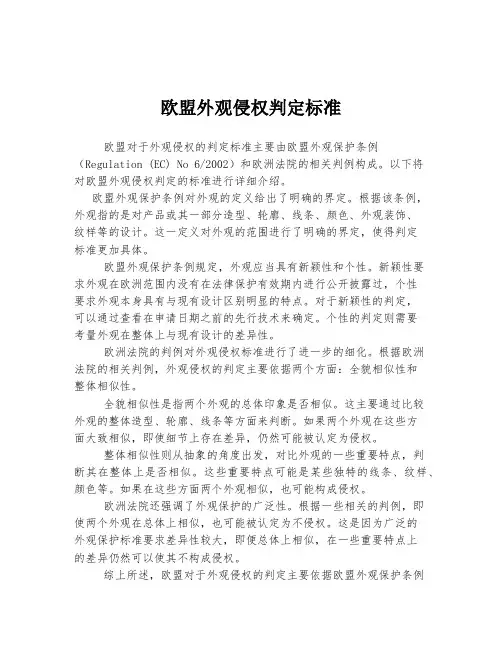
欧盟外观侵权判定标准欧盟对于外观侵权的判定标准主要由欧盟外观保护条例(Regulation (EC) No 6/2002)和欧洲法院的相关判例构成。
以下将对欧盟外观侵权判定的标准进行详细介绍。
欧盟外观保护条例对外观的定义给出了明确的界定。
根据该条例,外观指的是对产品或其一部分造型、轮廓、线条、颜色、外观装饰、纹样等的设计。
这一定义对外观的范围进行了明确的界定,使得判定标准更加具体。
欧盟外观保护条例规定,外观应当具有新颖性和个性。
新颖性要求外观在欧洲范围内没有在法律保护有效期内进行公开披露过,个性要求外观本身具有与现有设计区别明显的特点。
对于新颖性的判定,可以通过查看在申请日期之前的先行技术来确定。
个性的判定则需要考量外观在整体上与现有设计的差异性。
欧洲法院的判例对外观侵权标准进行了进一步的细化。
根据欧洲法院的相关判例,外观侵权的判定主要依据两个方面:全貌相似性和整体相似性。
全貌相似性是指两个外观的总体印象是否相似。
这主要通过比较外观的整体造型、轮廓、线条等方面来判断。
如果两个外观在这些方面大致相似,即使细节上存在差异,仍然可能被认定为侵权。
整体相似性则从抽象的角度出发,对比外观的一些重要特点,判断其在整体上是否相似。
这些重要特点可能是某些独特的线条、纹样、颜色等。
如果在这些方面两个外观相似,也可能构成侵权。
欧洲法院还强调了外观保护的广泛性。
根据一些相关的判例,即使两个外观在总体上相似,也可能被认定为不侵权。
这是因为广泛的外观保护标准要求差异性较大,即便总体上相似,在一些重要特点上的差异仍然可以使其不构成侵权。
综上所述,欧盟对于外观侵权的判定主要依据欧盟外观保护条例和欧洲法院的相关判例。
在判定过程中,需要考虑外观的新颖性和个性,判断其与现有设计的区别;还需要比较外观的全貌相似性和整体相似性,并且要考虑外观保护的广泛性。
这些判定标准的建立使得外观侵权的判定更加具体和科学。
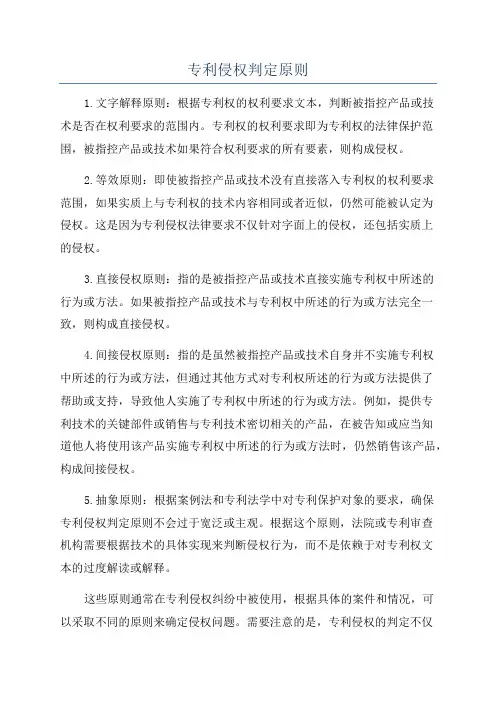
专利侵权判定原则1.文字解释原则:根据专利权的权利要求文本,判断被指控产品或技术是否在权利要求的范围内。
专利权的权利要求即为专利权的法律保护范围,被指控产品或技术如果符合权利要求的所有要素,则构成侵权。
2.等效原则:即使被指控产品或技术没有直接落入专利权的权利要求范围,如果实质上与专利权的技术内容相同或者近似,仍然可能被认定为侵权。
这是因为专利侵权法律要求不仅针对字面上的侵权,还包括实质上的侵权。
3.直接侵权原则:指的是被指控产品或技术直接实施专利权中所述的行为或方法。
如果被指控产品或技术与专利权中所述的行为或方法完全一致,则构成直接侵权。
4.间接侵权原则:指的是虽然被指控产品或技术自身并不实施专利权中所述的行为或方法,但通过其他方式对专利权所述的行为或方法提供了帮助或支持,导致他人实施了专利权中所述的行为或方法。
例如,提供专利技术的关键部件或销售与专利技术密切相关的产品,在被告知或应当知道他人将使用该产品实施专利权中所述的行为或方法时,仍然销售该产品,构成间接侵权。
5.抽象原则:根据案例法和专利法学中对专利保护对象的要求,确保专利侵权判定原则不会过于宽泛或主观。
根据这个原则,法院或专利审查机构需要根据技术的具体实现来判断侵权行为,而不是依赖于对专利权文本的过度解读或解释。
这些原则通常在专利侵权纠纷中被使用,根据具体的案件和情况,可以采取不同的原则来确定侵权问题。
需要注意的是,专利侵权的判定不仅仅是以上几个原则的简单叠加,还需要综合考虑其他因素,如专利的有效性、技术的先进性等。
因此,在实际应用中,专业的法律人员和专利专家应当根据具体情况综合运用这些原则来进行判定。
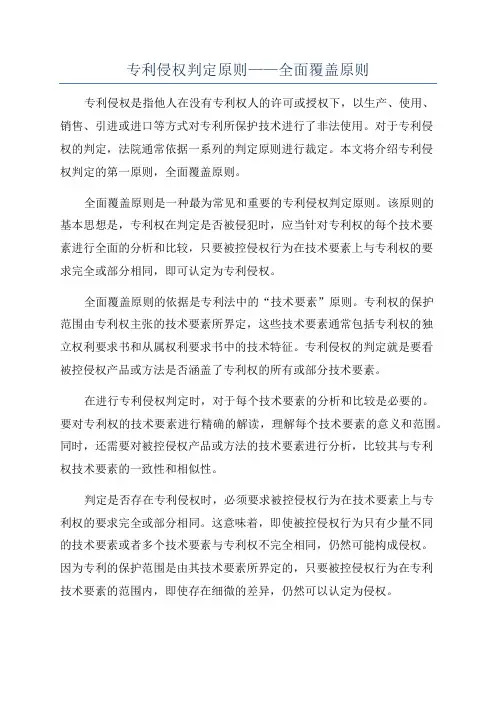
专利侵权判定原则——全面覆盖原则专利侵权是指他人在没有专利权人的许可或授权下,以生产、使用、销售、引进或进口等方式对专利所保护技术进行了非法使用。
对于专利侵权的判定,法院通常依据一系列的判定原则进行裁定。
本文将介绍专利侵权判定的第一原则,全面覆盖原则。
全面覆盖原则是一种最为常见和重要的专利侵权判定原则。
该原则的基本思想是,专利权在判定是否被侵犯时,应当针对专利权的每个技术要素进行全面的分析和比较,只要被控侵权行为在技术要素上与专利权的要求完全或部分相同,即可认定为专利侵权。
全面覆盖原则的依据是专利法中的“技术要素”原则。
专利权的保护范围由专利权主张的技术要素所界定,这些技术要素通常包括专利权的独立权利要求书和从属权利要求书中的技术特征。
专利侵权的判定就是要看被控侵权产品或方法是否涵盖了专利权的所有或部分技术要素。
在进行专利侵权判定时,对于每个技术要素的分析和比较是必要的。
要对专利权的技术要素进行精确的解读,理解每个技术要素的意义和范围。
同时,还需要对被控侵权产品或方法的技术要素进行分析,比较其与专利权技术要素的一致性和相似性。
判定是否存在专利侵权时,必须要求被控侵权行为在技术要素上与专利权的要求完全或部分相同。
这意味着,即使被控侵权行为只有少量不同的技术要素或者多个技术要素与专利权不完全相同,仍然可能构成侵权。
因为专利的保护范围是由其技术要素所界定的,只要被控侵权行为在专利技术要素的范围内,即使存在细微的差异,仍然可以认定为侵权。
全面覆盖原则在判定专利侵权方面具有重要的指导意义。
它使得专利法的保护可以达到更广泛和全面,确保专利权人的合法权益得到保护。
同时,它也要求对专利权和被控侵权行为进行细致的技术比较分析,确保对侵权问题的判定具有准确性和合理性。
然而,全面覆盖原则也存在一定的局限性。
在判定专利侵权时,如果严格要求被控侵权行为与专利技术要素完全相同,可能会对创新活动造成一定的抑制作用。
因此,在实际判定中,通常也会考虑被控侵权行为与专利技术要素的相似性和等效性,以便更好地平衡专利权人和被控侵权行为人的权益。
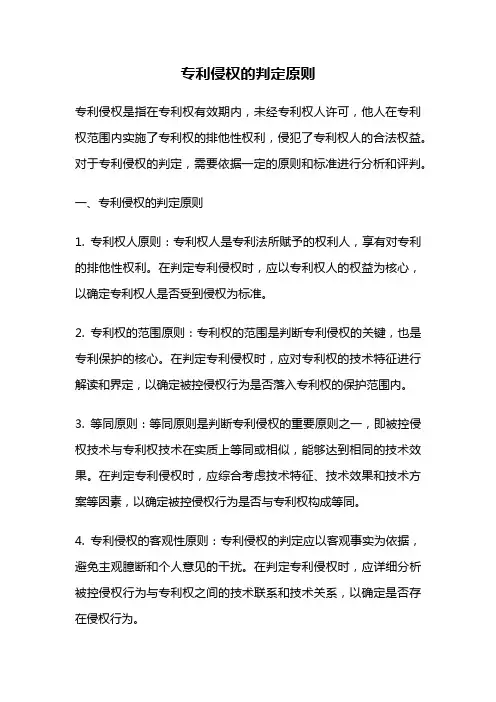
专利侵权的判定原则专利侵权是指在专利权有效期内,未经专利权人许可,他人在专利权范围内实施了专利权的排他性权利,侵犯了专利权人的合法权益。
对于专利侵权的判定,需要依据一定的原则和标准进行分析和评判。
一、专利侵权的判定原则1. 专利权人原则:专利权人是专利法所赋予的权利人,享有对专利的排他性权利。
在判定专利侵权时,应以专利权人的权益为核心,以确定专利权人是否受到侵权为标准。
2. 专利权的范围原则:专利权的范围是判断专利侵权的关键,也是专利保护的核心。
在判定专利侵权时,应对专利权的技术特征进行解读和界定,以确定被控侵权行为是否落入专利权的保护范围内。
3. 等同原则:等同原则是判断专利侵权的重要原则之一,即被控侵权技术与专利权技术在实质上等同或相似,能够达到相同的技术效果。
在判定专利侵权时,应综合考虑技术特征、技术效果和技术方案等因素,以确定被控侵权行为是否与专利权构成等同。
4. 专利侵权的客观性原则:专利侵权的判定应以客观事实为依据,避免主观臆断和个人意见的干扰。
在判定专利侵权时,应详细分析被控侵权行为与专利权之间的技术联系和技术关系,以确定是否存在侵权行为。
5. 全盘比较原则:全盘比较原则是判断专利侵权的重要原则之一,即对比被控侵权技术与专利权技术的技术特征、技术效果和技术方案等因素,全面比较二者的相似性和差异性。
在判定专利侵权时,应综合考虑被控侵权行为与专利权之间的技术共性和技术特殊性,以确定是否构成侵权。
6. 技术发展原则:专利侵权的判定应考虑到技术的发展和进步。
在判定专利侵权时,应充分考虑被控侵权行为是否基于技术发展和进步所产生,以确定是否构成侵权。
7. 恶意侵权原则:专利法对于恶意侵权行为有明确的惩罚规定。
在判定专利侵权时,应考虑被控侵权行为是否具有恶意侵权的主观故意,以确定是否适用恶意侵权的相关法律规定。
二、专利侵权的判定方法1. 技术比对法:通过对比被控侵权技术与专利权技术之间的技术特征和技术效果等因素,全面比较二者的相似性和差异性,以判断是否构成侵权。
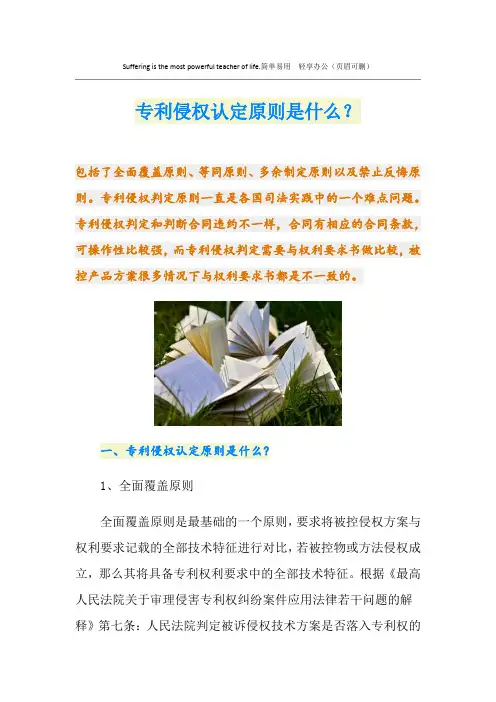
Suffering is the most powerful teacher of life.简单易用轻享办公(页眉可删)专利侵权认定原则是什么?包括了全面覆盖原则、等同原则、多余制定原则以及禁止反悔原则。
专利侵权判定原则一直是各国司法实践中的一个难点问题。
专利侵权判定和判断合同违约不一样,合同有相应的合同条款,可操作性比较强,而专利侵权判定需要与权利要求书做比较,被控产品方案很多情况下与权利要求书都是不一致的。
一、专利侵权认定原则是什么?1、全面覆盖原则全面覆盖原则是最基础的一个原则,要求将被控侵权方案与权利要求记载的全部技术特征进行对比,若被控物或方法侵权成立,那么其将具备专利权利要求中的全部技术特征。
根据《最高人民法院关于审理侵害专利权纠纷案件应用法律若干问题的解释》第七条:人民法院判定被诉侵权技术方案是否落入专利权的保护范围,应当审查权利人主张的权利要求所记载的全部技术特征。
2、等同原则多数情况下,专利侵权适用的是这个原则。
等同原则是指将被控物与权利要求记载的全部技术特征进行对比,虽然不完全具备其全部技术特征,但是被控物不具备的专利特征在被控物上面能够找到该特征的等同替换物,例如,等同替换、部件移位、分解或合并等。
此种情况下,被控物被判定侵权。
3、多余制定原则多余制定原则是指在专利侵权判定中,根据权利要求书的全部技术特征进行区分,分为必要技术特征和非必要技术特征,但仅以必要技术特征来作为专利权保护的范围,从而判定被控物是否覆盖专利权保护的范围。
若覆盖了,该被控物则构成侵权。
在适用该原则时应当注意非必要技术必须是与专利目的无关的次要部分,但是这种区分具有很大难度,所以在适用上要非常慎重。
4、禁止反悔原则禁止反悔原则又称审批过程禁反言,是为了限制等同原则而出现的,即指专利权人如果在专利审批过程中,为了满足法定授权要求而对权利要求的范围进行了限制性的修改或解释,则在主张专利权时,不得将通过该限缩而放弃的内容纳入专利权的保护范围。
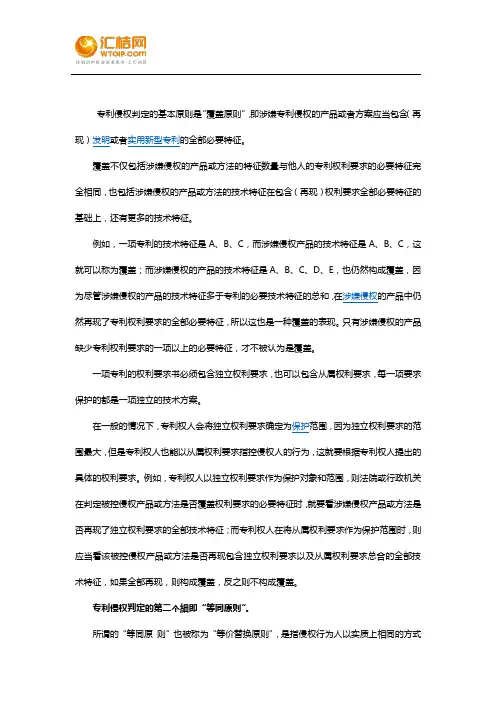
专利侵权判定的基本原则是“覆盖原则”,即涉嫌专利侵权的产品或者方案应当包含(再现)发明或者实用新型专利的全部必要特征。
覆盖不仅包括涉嫌侵权的产品或方法的特征数量与他人的专利权利要求的必要特征完全相同,也包括涉嫌侵权的产品或方法的技术特征在包含(再现)权利要求全部必要特征的基础上,还有更多的技术特征。
例如,一项专利的技术特征是A、B、C,而涉嫌侵权产品的技术特征是A、B、C,这就可以称为覆盖;而涉嫌侵权的产品的技术特征是A、B、C、D、E,也仍然构成覆盖,因为尽管涉嫌侵权的产品的技术特征多于专利的必要技术特征的总和,在涉嫌侵权的产品中仍然再现了专利权利要求的全部必要特征,所以这也是一种覆盖的表现。
只有涉嫌侵权的产品缺少专利权利要求的一项以上的必要特征,才不被认为是覆盖。
一项专利的权利要求书必须包含独立权利要求,也可以包含从属权利要求,每一项要求保护的都是一项独立的技术方案。
在一般的情况下,专利权人会将独立权利要求确定为保护范围,因为独立权利要求的范围最大,但是专利权人也能以从属权利要求指控侵权人的行为,这就要根据专利权人提出的具体的权利要求。
例如,专利权人以独立权利要求作为保护对象和范围,则法院或行政机关在判定被控侵权产品或方法是否覆盖权利要求的必要特征时,就要看涉嫌侵权产品或方法是否再现了独立权利要求的全部技术特征;而专利权人在将从属权利要求作为保护范围时,则应当看该被控侵权产品或方法是否再现包含独立权利要求以及从属权利要求总合的全部技术特征,如果全部再现,则构成覆盖,反之则不构成覆盖。
专利侵权判定的第二个細即“等同原则”。
所谓的“等同原则”也被称为“等价替换原则”,是指侵权行为人以实质上相同的方式或手段(等效手段)替换属于专利保护的部分者全部的必要技术特征,但却与专利保护的发明创造产生实质上相同的效果。
根据这一定义,如果对专利产品或者方法的某些改变与专利产品或者方法之间具有等效性,那么依然会构成侵犯专利权的行为。

专利侵权判定的原则
专利侵权判定的原则是指在诉讼中判定行为是否侵犯他人专利权应该遵循的原则。
这里介绍几个判定侵权的原则。
首先,侵权必须具备侵犯专利权要件。
专利权是指授予专利权人对专利实施进行控制的一种独特的权利。
在诉讼中,要证明被控诉的行为是否构成专利侵权,必须要先证明行为是否具备侵犯专利权的要件。
这些要件包括专利权的主体、专利的技术方案、专利权的有效性等。
其次,在诉讼中,要确定侵权是否存在,需要将被控诉方的行为与专利权要件进行对比,其中应包括专利权的独创性和公开性等。
如果被控诉方的行为在这些方面与专利存在重合,就可以认定其行为构成专利侵权。
最后,专利权人在诉讼中要证明被控诉方的行为与专利权要件相符,还需要证明这种行为是否具备侵权的目的和效果。
如果行为的目的和效果与专利权人的技术方案一致,即被控诉方的行为是为了获得专利权人的技术成果所带来的利益,那么就可以认定行为构成专利侵权。
总之,专利侵权判定的原则十分重要,需要在诉讼中认真遵循。
只有依据这些原则进行判定,才能保障专利权人的合法权益,促进科技进步和经济发展。
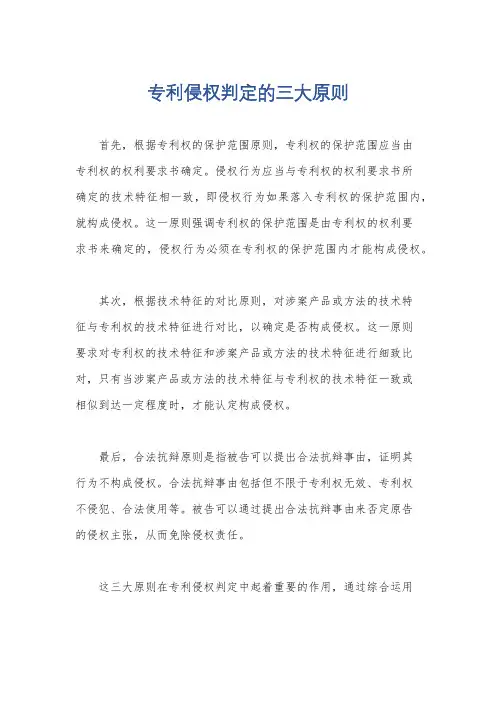
专利侵权判定的三大原则
首先,根据专利权的保护范围原则,专利权的保护范围应当由
专利权的权利要求书确定。
侵权行为应当与专利权的权利要求书所
确定的技术特征相一致,即侵权行为如果落入专利权的保护范围内,就构成侵权。
这一原则强调专利权的保护范围是由专利权的权利要
求书来确定的,侵权行为必须在专利权的保护范围内才能构成侵权。
其次,根据技术特征的对比原则,对涉案产品或方法的技术特
征与专利权的技术特征进行对比,以确定是否构成侵权。
这一原则
要求对专利权的技术特征和涉案产品或方法的技术特征进行细致比对,只有当涉案产品或方法的技术特征与专利权的技术特征一致或
相似到达一定程度时,才能认定构成侵权。
最后,合法抗辩原则是指被告可以提出合法抗辩事由,证明其
行为不构成侵权。
合法抗辩事由包括但不限于专利权无效、专利权
不侵犯、合法使用等。
被告可以通过提出合法抗辩事由来否定原告
的侵权主张,从而免除侵权责任。
这三大原则在专利侵权判定中起着重要的作用,通过综合运用
这些原则,可以全面客观地判定专利侵权案件,保护专利权人的合法权益,也能确保被告的合法权益不受侵害。
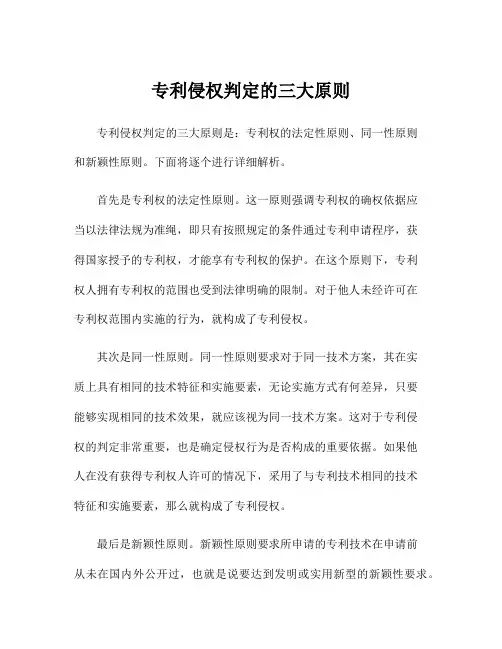
专利侵权判定的三大原则专利侵权判定的三大原则是:专利权的法定性原则、同一性原则和新颖性原则。
下面将逐个进行详细解析。
首先是专利权的法定性原则。
这一原则强调专利权的确权依据应当以法律法规为准绳,即只有按照规定的条件通过专利申请程序,获得国家授予的专利权,才能享有专利权的保护。
在这个原则下,专利权人拥有专利权的范围也受到法律明确的限制。
对于他人未经许可在专利权范围内实施的行为,就构成了专利侵权。
其次是同一性原则。
同一性原则要求对于同一技术方案,其在实质上具有相同的技术特征和实施要素,无论实施方式有何差异,只要能够实现相同的技术效果,就应该视为同一技术方案。
这对于专利侵权的判定非常重要,也是确定侵权行为是否构成的重要依据。
如果他人在没有获得专利权人许可的情况下,采用了与专利技术相同的技术特征和实施要素,那么就构成了专利侵权。
最后是新颖性原则。
新颖性原则要求所申请的专利技术在申请前从未在国内外公开过,也就是说要达到发明或实用新型的新颖性要求。
如果在专利权有效期内,他人提出了前于该专利申请日的技术文件或公开资料,揭示了与该专利技术相同的技术方案,那么该专利技术就失去了新颖性。
这样的技术文件或公开资料被称为“先知技术”,如果他人在该专利技术申请日之后实施了先知技术所揭示的技术方案,那么就构成了专利侵权。
综上所述,专利侵权判定的三大原则,即专利权的法定性原则、同一性原则和新颖性原则,共同构成了专利侵权的基本依据和判定准则。
专利侵权的行为依据这些原则进行判断,只有在明确违反这些原则时,才能认定为专利侵权行为,进而采取相应的法律措施进行维权和惩罚。
这些原则的制定和遵守,有助于保护专利权人的利益,促进创新能力的提升,推动技术进步和经济发展。
同时,对于专利侵权案件的审理和裁决也提供了明确的法律依据,加强了司法公正性和依法治理的原则。
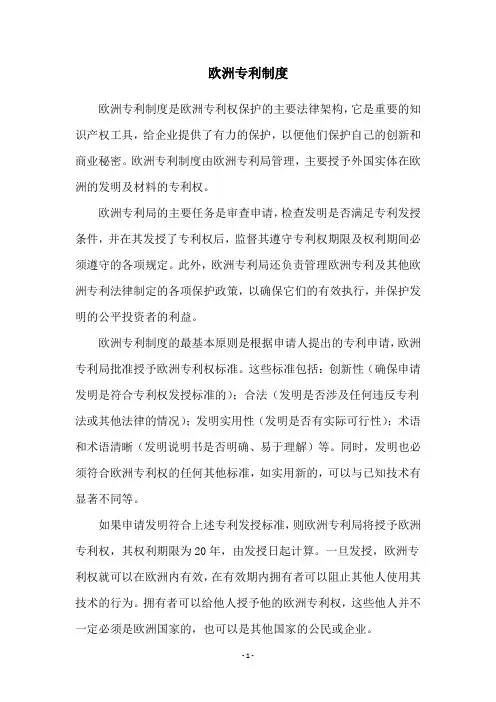
欧洲专利制度欧洲专利制度是欧洲专利权保护的主要法律架构,它是重要的知识产权工具,给企业提供了有力的保护,以便他们保护自己的创新和商业秘密。
欧洲专利制度由欧洲专利局管理,主要授予外国实体在欧洲的发明及材料的专利权。
欧洲专利局的主要任务是审查申请,检查发明是否满足专利发授条件,并在其发授了专利权后,监督其遵守专利权期限及权利期间必须遵守的各项规定。
此外,欧洲专利局还负责管理欧洲专利及其他欧洲专利法律制定的各项保护政策,以确保它们的有效执行,并保护发明的公平投资者的利益。
欧洲专利制度的最基本原则是根据申请人提出的专利申请,欧洲专利局批准授予欧洲专利权标准。
这些标准包括:创新性(确保申请发明是符合专利权发授标准的);合法(发明是否涉及任何违反专利法或其他法律的情况);发明实用性(发明是否有实际可行性);术语和术语清晰(发明说明书是否明确、易于理解)等。
同时,发明也必须符合欧洲专利权的任何其他标准,如实用新的,可以与已知技术有显著不同等。
如果申请发明符合上述专利发授标准,则欧洲专利局将授予欧洲专利权,其权利期限为20年,由发授日起计算。
一旦发授,欧洲专利权就可以在欧洲内有效,在有效期内拥有者可以阻止其他人使用其技术的行为。
拥有者可以给他人授予他的欧洲专利权,这些他人并不一定必须是欧洲国家的,也可以是其他国家的公民或企业。
欧洲专利权的发授赋予了拥有者特定的权利,可以阻止任何无授权的使用和交易他的发明,或者招致侵权行为。
欧洲专利权还为拥有者提供了具体的司法救济,可以用来向非法使用者追索损失,或者要求禁止他们使用发明并索回其利润。
此外,欧洲专利制度也提供了许可机制,如授权许可,允许拥有者将他的欧洲专利权转让给他人,以换取一定的报酬。
此外,欧洲专利局还可以授予豁免许可,允许特定类型的使用者免费使用发明,以最大限度地促进发明的使用和发展。
因此,欧洲专利制度对知识产权的保护和发展起着至关重要的作用,它可以保护发明投资者的利益,帮助他们获得合理的报偿。
专利侵权行为判定原则
专利侵权行为判定原则是指对专利权利的侵犯行为进行判定的基本原则。
在判定专利侵权行为时,需要考虑到专利权的内容、使用方式、技术特点等因素,以确定是否构成侵权行为。
下面是一些参考内容。
1. 权利要素匹配原则:根据专利权利要求书和说明书,判断被控侵权产品或方法是否与专利权利要求书中的技术特征一一对应。
如果被控侵权产品或方法具备专利的主要技术特征,即使有一些次要的差异,也可能构成侵权。
2. 构成整体规避原则:当被控侵权产品或方法在外观上、结构上或使用方式上与专利相似,并且具备专利技术的重要特征,即使细节上有些不同,也可能构成侵权。
3. 构成等同替代原则:被控侵权产品或方法只要能够实现专利技术的同样效果,即使通过不同的技术手段实现,也可能构成侵权。
4. 组合特征原则:对于专利权仅仅是对一部分技术特征进行了保护的情况,被控侵权产品或方法如果使用该部分特征,且与该部分特征和其他技术特征的组合效果相似,也可能构成侵权。
5. 法定例外原则:根据专利法的规定,某些特定行为可能不构成侵权,如个人及非商业目的的个人使用、试验使用、科研使用等例外情况。
6. 损害赔偿原则:如果侵权行为已经给专利权人造成了经济损失,被判侵权方需要承担相应的赔偿责任。
赔偿金额可以包括实际损失和侵权行为带来的利润。
以上是一些常见的专利侵权行为判定原则的参考内容。
实际判定专利侵权行为时,还需要考虑具体的案件情况、专利技术的独创性、被控侵权产品或方法的市场影响等因素,综合进行判断。
一、专利侵权判断原则有哪些(一)全面覆盖原则全面覆盖原则是专利侵权判定中的一个最基本原则,所谓全面覆盖原则,是指如果被控物或者方法侵权成立,那么该产品或者方法应该具备专利权利要求中所描述的每一项特征,缺一不可。
在判定专利侵权时,最先适用的是全面覆盖原则。
在下述几种情况下,视为被控物全面覆盖了专利的权利要求。
1、字面侵权。
即从字面上分析比较就可以认定被控物的技术特征与专利的必要特征相同。
比如,一项专利,其权利要求为:H型强场磁化杯体(1),其特征在于:杯体的两侧各镶嵌一块永久磁铁(2)。
如果被控物的杯体两侧各镶嵌了一块永久磁铁,那么可以看到,被控物的结构与权利要求所描述的结构一模一样。
2、专利权利要求中使用的是上位概念,被控物公开的结构属于上位概念中的具体概念,此种情况下适用全面覆盖原则,被控物侵权。
比如,一项专利,其权利要求为,一种新型机器人行走机构,其特征在于:电机接传动机构,传动机构的输出轴上装有驱动轮。
被控物的结构为,电机经齿轮传动,输出轴上装有驱动轮。
被控物采用齿轮传动,齿轮传动的结构属于传动机构的具体概念,因此,被控物属于侵权。
(二)等同原则等同原则认为,将被控侵权的技术构成与专利权利要求书记载的相应技术特征进行比较,如果所属技术领域的普通技术人员在研究了专利权人的说明书和权利要求后,不经过创造性的智力劳动就能够联想到的,诸如采用等同替换、部件移位、分解或合并等替代手段实现专利的发明目的和积极效果的,并且与专利技术相比,在目的、功能、效果上相同或者基本相同的,则应当认定侵权成立。
具有六个沿圆周方向均匀分布的驱动臂,驱动臂内设置有电机,电机经齿轮传动接位于驱动臂端部的驱动轮。
被控物的结构为,具有六个沿圆周方向均匀分布的驱动臂,驱动臂内设置有电机,电机经链条传动接位于驱动臂端部的驱动轮。
被控物缺少专利权利权利要求中的齿轮传动特征,但是由于链条传动属于齿轮传动的等同替换,所以被控物适用等同原则,属于侵权。
德国专利侵权诉讼制度
德国的专利侵权诉讼制度主要由德国专利法和刑事诉讼法以及一些相关的法规组成。
德国专利法确立了专利所有人对侵权行为的追索权,并规定了专利侵权诉讼程序。
根据该法,专利所有人可以向当地法院提起专利侵权诉讼,要求停止侵权行为并获得赔偿。
专利侵权诉讼程序一般包括以下步骤:起诉、庭前调解、庭审和判决等。
在德国,专利侵权诉讼可以采取两种程序:普通程序和简化程序。
普通程序适用于复杂的案件,包括专利有效性的争议等;而简化程序适用于侵权事实明确、争议较少的案件。
简化程序一般更迅速,成本也较低。
德国的专利侵权诉讼制度还涉及临时禁令(preliminary injunction)的机制。
如果专利所有人认为其专利正在被侵权,可以向法院申请临时禁令,要求立即停止侵权行为。
德国法院在判决临时禁令时,通常会进行权衡利益,并对侵权行为的可能性和后果进行评估。
此外,德国专利侵权诉讼制度还规定了追溯性损害赔偿
(back-dated damages)的原则。
专利侵权行为所造成的经济
损失可以由法院判决赔偿,其中包括实际损失和被侵权人因未授权使用专利而被放弃的利益。
总体而言,德国专利侵权诉讼制度相对严谨和高效,旨在保护专利权益,并通过赔偿制度来维护专利所有人的正当权益。
怎么判定专利侵权,有什么判定原则我国规定的专利包括发明创造、实⽤新型以及外观设计,侵犯其中⼀种专利项⽬都是违法的,那怎么判定专利侵权,有什么判定原则?接下来由店铺的⼩编为⼤家整理了⼀些关于这⽅⾯的知识,欢迎⼤家阅读!怎么判定专利侵权,有什么判定原则⼀、发明和实⽤新型专利侵权判定(⼀)判定原则1、全⾯覆盖原则全⾯覆盖是指被控侵权物(产品或⽅法)将专利权利要求中记载的技术⽅案的必要技术特征全部再现,被控侵权物(产品或⽅法)与专利独⽴权利要求中记载的全部必要技术特征⼀⼀对应并且相同。
全⾯覆盖原则是专利侵权判定中的⼀个最基本原则。
主要包括以下⼏种形式:(1)字⾯侵权⼜称全部技术特征覆盖,即如果被控侵权物(产品或⽅法)的技术特征包含了专利权利要求中记载的全部必要技术特征,则落⼊专利权的保护范围。
(2)上位概念侵权当专利独⽴权利要求中记载的必要技术特征采⽤的是上位概念特征,⽽被控侵权物(产品或⽅法)采⽤的是相应的下位概念特征时,则被控侵权物(产品或⽅法)落⼊专利权的保护范围。
(3)特征数量侵权如被控侵权物(产品或⽅法)在利⽤专利权利要求中的全部必要技术特征的基础上,⼜增加了新的技术特征,仍落⼊专利权的保护范围。
此时,不考虑被控侵权物(产品或⽅法)的技术效果与专利技术是否相同。
(4)从属专利侵权被控侵权物(产品或⽅法)对在先专利技术⽽⾔是改进的技术⽅案,并且获得了专利权,则属于从属专利⼜称依存专利。
未经在先专利权⼈许可,实施从属专利也覆盖了在先专利权的保护范围。
2、等同原则“等同原则”的概念:是指以基本相同的⼿段,实现基本相同的功能,达到基本相同的效果,并且所属领域的技术⼈员在侵权⾏为发⽣时通过阅读说明书、附图和权利要求书,⽆需经过创造性劳动就能够联想到的特征。
等同原则的“等同”,是指具体技术特征在功能、作⽤上的等同,⽽不是侵权产品与专利两个技术⽅案的整体等同。
故被控侵权产品该三个技术特征的结合与专利权利要求必要技术特征“弹性罩边”是以基本相同的⼿段,实现基本相同的功能,达到了基本相同的效果,应认定是等同的。
专利侵权判定的主要规则1.专利权利要求的解释专利权利要求是对专利权的确定范围进行了具体表述的部分。
依据《专利法》和相关法规,对权利要求的解释主要采用了以下原则:-字面解释原则:根据权利要求的措辞进行解释,将其理解为字面上的含义。
-专利文件的整体原则:由于专利权利要求通常包括多个条款,权利要求的解释需要综合考虑权利要求的全文。
-技术领域的一般知识原则:解释权利要求时可以参考技术领域的一般知识,以了解术语和概念的常规含义。
-领先专利原则:如果先前的专利文件揭示了类似的技术,新专利的权利要求不能超过或损害领先专利的权益。
2.专利侵权的判定标准专利侵权的判定标准是依据专利权特有的概念和要求,在具体案件中进行判定的依据。
主要判定标准如下:-权利要求相同原则:侵权行为应当与专利权利要求的技术特征相同或足以产生同样的技术效果。
-范围概念原则:专利权利的范围由专利权利要求所确定,侵权行为应当在权利要求的范围内。
-技术效果原则:侵权行为应当实现专利权利要求所揭示的技术效果。
-同样的基础上应当继续追究原则:即使专利权利要求有一定的变化或修改,只要其基本的专利创造思维保持一致,仍可认定为侵权。
3.对专利侵权的证据要求在专利侵权案件中,为了证明侵权行为,需要提供相应的证据。
主要的证据要求包括:-专利权证明:原告应当提供对专利权的证明,例如专利证书或专利权确认文件等。
-专利权利要求证明:原告需要提供专利权利要求的原本或副本,以证明侵权行为是否涉及专利权利要求的技术特征。
-侵权行为证明:原告需要提供能够证明被告实施了专利权利要求所揭示技术特征的证据,例如产品、设备、文件等。
-专利侵权调查报告:原告可以委托专利侵权调查机构进行调查,并提供调查报告作为证据。
-专利侵权损失证据:对于侵权造成的经济损失,在一些国家或地区,原告需要提供经济损失的证明。
总之,专利侵权判定的主要规则包括专利权利要求的解释、专利侵权的判定标准和对专利侵权的证据要求。
欧洲侵权行为法原则Translator: Yu MinTranslation checker: Bi XiaoqingEuropean Group on Tort Law European Group on Tort Law Principles of European Tort Law欧洲侵权行为法原则TITLE I. Basic Norm 第1篇基本规范Chapter 1. Basic Norm 第1章基本规范Art. 1:101. Basic norm 第1:101条基本规范(1) A person to whom damage to another is legally attributed is liable to compensate that damage. (1) 给他人造成的损害由法律上被归责者负赔偿该损害之责任。
(2) Damage may be attributed in particular tothe person(2) 损害特别可以被归责于以下人:a) whose conduct constituting fault has causedit; ora) 其构成过错的行为引起损害者;或b) whose abnormally dangerous activity hascaused it; orb) 从事异常危险活动的行为引起损害者;或c) whose auxiliary has caused it within thescope of his functions.c) 其辅助者在其职责范围内引起损害者。
TITLE II. General Conditions of Liability 第2篇一般责任要件Chapter 2. Damage 第2章损害Art. 2:101. Recoverable damage 第2:101条可回复的损害Damage requires material or immaterial harm to a legally protected interest. 损害需为对受保护的法律上利益的物质上或非物质上的侵害。